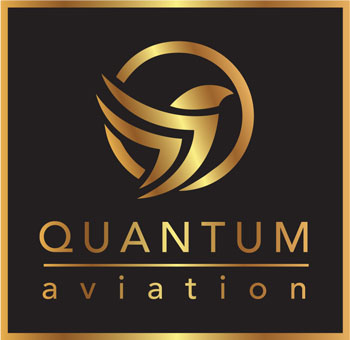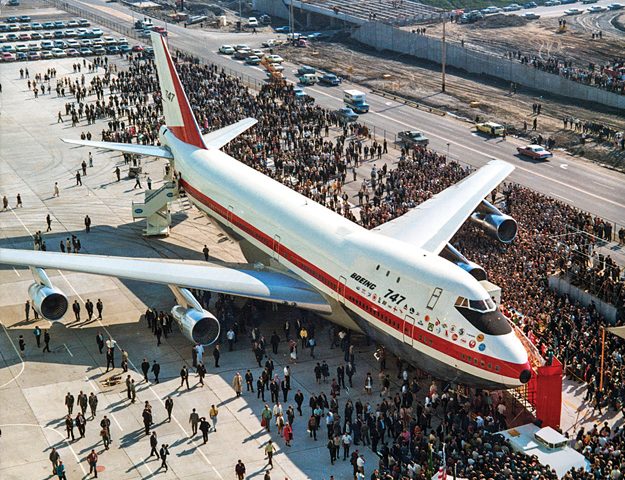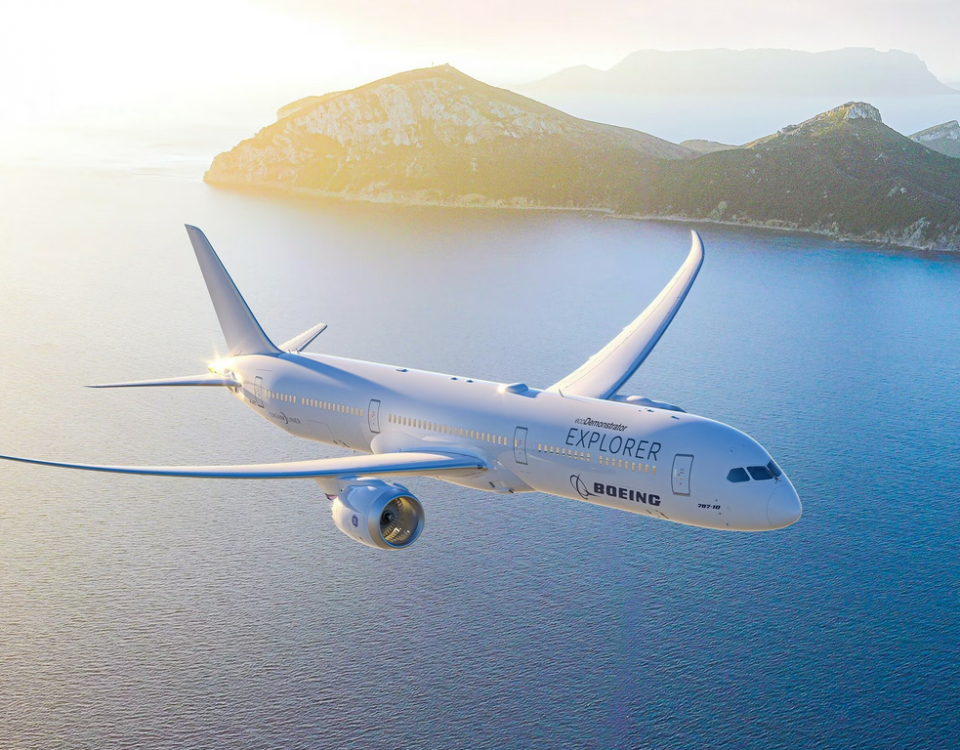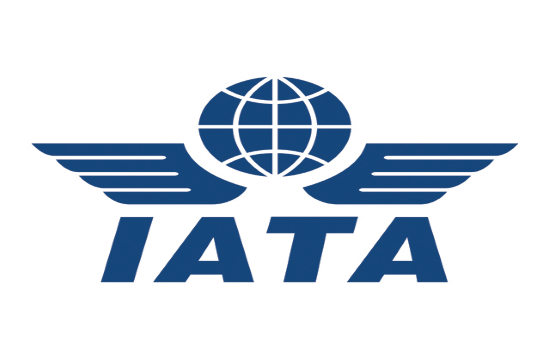
AVSEC World Conference Looks at Disrupters & Enablers to Aviation Security
January 28, 2019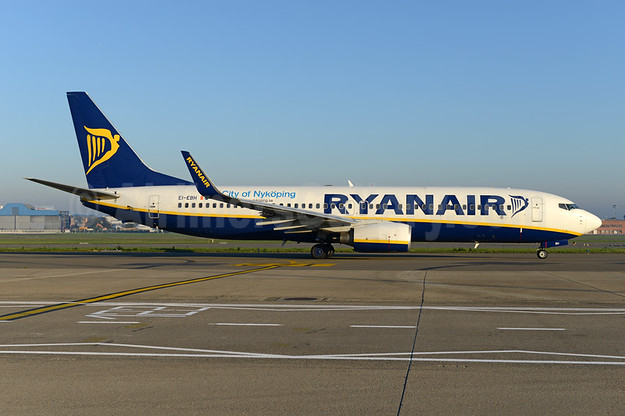
Ryanair launches its winter 2019 schedule
January 28, 2019On September 30, 1968 Boeing displayed to the public for the first time the first prototype of the Boeing 747-100 when it was rolled out of the new Paine Field facility at Everett, WA (above). Photo: Boeing.
The first flight was successfully conducted on February 9, 1969.
On January 15, 1970, Pat Nixon, the First Lady of the United States, christened Pan Am’s first Boeing 747-100.
The first Pan Am Boeing 747-100 entered revenue service on January 22, 1970, on the New York (JFK) – London (Heathrow) route. The flight had been scheduled for the previous evening on January 21, but engine overheating cancelled the originally scheduled inaugural flight.


Joe Sutter was recognized by Boeing as the “Father of the 747”. On his passing in 2016, Boeing issued this tribute:
We lost one of the giants of aerospace and a beloved member of the Boeing family. Joe Sutter, the “Father of the 747,” passed away at the age of 95.
Joe lived an amazing life and was an inspiration – not just to those of us at Boeing, but to the entire aerospace industry. He personified the ingenuity and passion for excellence that made Boeing airplanes synonymous with quality the world over.
Early in Joe’s career, he had a hand in many iconic commercial airplane projects, including the Dash 80, its cousin the 707 and the 737. But it was the 747 – the world’s first jumbo jet – that secured his place in history.
Joe led the engineering team that developed the 747 in the mid-1960s, opening up affordable international travel and helping connect the world. His team, along with thousands of other Boeing employees involved in the project, became known as the Incredibles for producing what was then the world’s largest airplane in record time – 29 months from conception to rollout. It remains a staggering achievement and a testament to Joe’s “incredible” determination.
Long after he retired, Joe remained very active within the company. He continued to serve as a consultant on the Commercial Airplanes Senior Advisory Group, and he was still a familiar sight to many of us working here. By then his hair was white and he moved a little slower, but he always had a twinkle in his eye, a sharp mind and an unwavering devotion to aerospace innovation and The Boeing Company. Fittingly, he was on hand to celebrate our centennial at the Founders Day weekend. He was one of a kind.
Joe was loved. He made a difference in the world. He made a difference to us. We will miss him and cherish our time with him.
Ray
Boeing issued this historical snapshot of the Boeing 747:

The 747 was the result of the work of some 50,000 Boeing people. Called “the Incredibles,” these were the construction workers, mechanics, engineers, secretaries and administrators who made aviation history by building the 747 — the largest civilian airplane in the world — in less than 16 months during the late 1960s.
The incentive for creating the giant 747 came from reductions in airfares, a surge in air-passenger traffic and increasingly crowded skies. Following the loss of the competition for a gigantic military transport, the C-5A, Boeing set out to develop a large advanced commercial airplane to take advantage of the high-bypass engine technology developed for the C-5A. The design philosophy behind the 747 was to develop a completely new plane, and other than the engines, the designers purposefully avoided using any hardware developed for the C-5.
The 747’s final design was offered in three configurations: all passenger, all cargo and a convertible passenger/freighter model. The freighter and convertible models loaded 8- by 8-foot (2.4- by 2.4-meter) cargo containers through the huge hinged nose.
The 747 was truly monumental in size. The massive airplane required construction of the 200 million-cubic-foot (5.6 million-cubic-meter) 747 assembly plant in Everett, Wash., the world’s largest building (by volume). The fuselage of the original 747 was 225 feet (68.5 meters) long; the tail as tall as a six-story building. Pressurized, it carried a ton of air. The cargo hold had room for 3,400 pieces of baggage and could be unloaded in seven minutes. The total wing area was larger than a basketball court. Yet, the entire global navigation system weighed less than a modern laptop computer.
Pilots prepared for the 747 at Boeing training school. The experience of taxiing such a large plane was acquired in a contraption called “Waddell’s Wagon,” named after Jack Waddell, the company’s chief test pilot. The pilot sat in a mockup of the 747 flight deck built atop three-story-high stilts on a moving truck. The pilot learned how to maneuver from such a height by directing the truck driver below him by radio.
The National Aeronautics and Space Administration later modified two 747-100s into Shuttle Carrier Aircraft. The next version, the 747-200, holds approximately 440 passengers and has a range of about 5,600 nautical miles (10,371 kilometers). In 1990, two 747-200Bs were modified to serve as Air Force One and replaced the VC-137s (707s) that served as the presidential airplane for nearly 30 years. The 747-300 has an extended upper deck and carries even more passengers than the -200.
Video: Boeing.
The 747-400 rolled out in 1988. Its wingspan is 212 feet (64 meters), and it has 6-foot-high (1.8-meter-high) “winglets” on the wingtips. The 747-400 also is produced as a freighter, as a combination freighter and passenger model, and as a special domestic version, without the winglets, for shorter range flights.
In August 1999, major assembly began on a militarized 747-400 Freighter to be used as a platform for the U.S. Air Force’s Airborne Laser (ABL) program. It rolled out on Oct. 27, 2006, and was eventually designated YAL-1. Boeing was the prime contractor for ABL, which was designed to provide a speed-of-light capability to destroy all classes of ballistic missiles in their boost phase of flight. Boeing provided the modified aircraft and the battle management system and is the overall systems integrator. ABL partners were Northrop Grumman, which supplied the chemical oxygen iodine, or COIL, high-energy laser associated lasers, and Lockheed Martin, which provided the nose-mounted turret in addition to the beam control/fire control system. On Feb. 11, 2010, the flying test bed destroyed a ballistic missile off the coast of Southern California. The program was canceled in 2011, and in 2012, YAL-1 was flown to the U.S. Air Force “bone yard” near Pima, Ariz., to be scrapped.
Another variant is the Dreamlifter — a specially modified 747-400 — that transports the large composite structures, including huge fuselage sections of the 787 Dreamliner, from partners around the world to Everett, Wash., and Charleston, S.C., for final assembly. The massive cargo is loaded and unloaded from a hinged rear fuselage. The last of the series four was delivered Feb. 16, 2010.
The longer range 747-400 airplanes (also known as 747-400ERs) were launched in late 2000. The 747-400ER (Extended Range) family is available in both passenger and freighter versions. The airplanes are the same size as current 747-400s and have a range of 7,670 nautical miles (14,205 kilometers) as opposed to the 747-400 range of 7,260 nautical miles (13,450 kilometers). It incorporates the strengthened -400 Freighter wing, strengthened body and landing gear, and an auxiliary fuel tank in the forward cargo hold, with an option for a second tank. When the 747-400ER’s full-range capability is not needed, operators can remove the tank (or tanks), freeing up additional space for cargo.
In November 2005, Boeing launched the 747-8 family — the 747-8 Intercontinental passenger airplane and the 747-8 Freighter. These airplanes incorporate innovative technologies from the 787 Dreamliner. In fact, the designation 747-8 was chosen to show the technology connection between the 787 Dreamliner and the new 747-8, including the General Electric GEnx-2B engines, raked wingtips and other improvements that allow for a 30 percent smaller noise footprint, 15 percent reduction in-service carbon emissions, better performance retention, lower weight, less fuel consumption, fewer parts and less maintenance.
The 747-8 Freighter first flew on February 8, 2010. The airplane is 250 feet, 2 inches (76.3 meters) long, which is 18 feet, 4 inches (5.6 meters) longer than the 747-400 Freighter. The stretch provides customers with 16 percent more revenue cargo volume compared with its predecessor. That translates to an additional four main-deck pallets and three lower hold pallets.
The passenger version, the Boeing 747-8 Intercontinental, serves the 400- to 500-seat market and took its first flight on March 20, 2011. The cabin’s sculpted ceilings, bigger overhead and side stowbins, a redesigned staircase and dynamic LED lighting all add to an overall more comfortable passenger experience. With 51 additional seats and 26 percent more revenue cargo volume than the 747-400, Boeing delivered the first 747-8 Intercontinental to an undisclosed Boeing Business Jet customer on Feb. 28, 2012. Launch customer Lufthansa took delivery of the first airline Intercontinental April 25, 2012.
On June 28, 2014, Boeing delivered the 1,500th 747 to come off the production line to Frankfurt, Germany-based Lufthansa. The 747 is the first wide-body airplane in history to reach the 1,500 milestone.
Some of the Boeing 747-300 operators: CLICK HERE
Lufthansa joined the celebrations and issued this statement:

It’s been 50 years since the first Boeing 747-100 took off over Seattle on its official maiden flight on February 9, 1969 – to the cheers of thousands of spectators. The Boeing 747-100 was the largest jet airliner the world had ever seen.
The success story of the Boeing 747 aircraft family started in the mid-60s, when Boeing developed a wide-body jet as an answer to the growing aviation needs. After less than four years of planning and development, in which Lufthansa engineers also took part, the jet, built from around six million individual parts, was ready to take to the skies.

The first Boeing 747-130 with the Lufthansa registration “D-ABYA” carried the production number 12. The “Yankee Alpha”, as it was called within the company, was handed over to Lufthansa on March 9, 1970 and was deployed on the Frankfurt-New York route for the first time on April 26, 1970. Lufthansa was the first European airline to provide its passenger the opportunity to fly by Jumbo Jet, being the second international airline following Pan American World Airways (PanAm).

The excitement of the passengers and crew on board was immense. Right from the entrance point to the jet, one gets into a “celebrative champagne mood”, a journalist wrote at that time. Hardly surprising, when considering that there was a bar in the First Class Lounge on the upper deck of the aircraft. To this day, the “hump” of the Boeing 747, which houses the cockpit and upper deck, remains the distinguishing feature of the Jumbo Jet in comparison to all other types of aircraft. The silhouette of the Boeing 747 has shaped the jet age and is still a style icon for many aviation enthusiasts.
The Boeing 747, with almost 70 meters in length and a span of nearly 60 meters, was christened by the American press as “Jumbo Jet”, offering space for 365 passengers at Lufthansa. The height of the tail unit, approximately 19 meters, was higher than a five-story building. The aircraft had a four-engine wide-body. These engines achieved more than twice the performance of a Boeing 707, which had previously been used on long-haul flights in intercontinental air traffic, but could only accommodate about 150 passengers.
Before accepting its first Jumbo Jet, Lufthansa had to adapt its aircraft and passenger handling so that they could cope with the different dimensions of the aircraft. New passenger boarding bridges, special tractors, kitchen lift trucks and tanker trucks were all developed at Frankfurt Airport, including a 27,000 square meter aircraft hangar with space for up to six Jumbo Jets. In addition, further counters had to be made available in the check-in hall.
After Lufthansa had also operated its successor models (the 747-200 and 747-400), Lufthansa was the world’s first passenger airline to receive the first Jumbo Jet’s “grandson”, the Boeing 747-8, on May 2nd, 2012. The modern aircraft can accommodate up to 364 passengers in First, Business, Premium Economy and Economy Class. It consumes just over three liters of fuel per passenger over 100 kilometers and has 30 percent lower noise emissions than its predecessor. When Lufthansa unveiled its new brand look about a year ago, a Boeing 747-8 was the first aircraft to be presented in the new livery. Like the first 747 aircraft 50 years ago, this machine is called “Yankee Alpha”, too.
The Jumbo Jet did not only have a career as a passenger aircraft. In March 1972, Lufthansa took on the world’s “first smiling Boeing” – the freight version, the Boeing 747-230F. Its prow opened up horizontally, making it easy to load even bulky goods. The Jumbo Jet was nicknamed the “Beetle swallower”, as it had space for 72 VW Beetles in its fuselage.
Happy Birthday, Jumbo!
United’s tribute to the Boeing 747:

